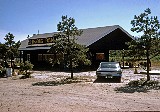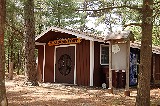Trading Posts
Every first year camper learns, about 15 seconds into his first visit to camp, just where to go to get their merit badge pamphlets, t-shirts, basket kits, souvenirs, and, of course, enough candy and snacks to maintain a week-long sugar high: the Trading Post. They then have to try to budget whatever funds Mom & Dad have sent with them to stretch them the whole week. While there has always been a Trading Post at Cachalot, exactly where you’d go or what you’d find there has changed a bit over the years.
In Cachalot’s earliest years of operation, very few buildings had yet been built. For those early years, the 21 Club served multiple purposes, including serving as the camp’s Trading Post. The trading post inventory from the 1948 end-of-camp report lists items that would be familiar to a Scout at Cachalot this summer: handicraft and metalworking supplies, pocketknives, and various items from the BSA’s National Supply office.
The first dedicated Trading Post was built in the early 1950s, a small shed-roof building with swing-up service windows close to the camp waterfront. Used as the Trading Post from the early 1950s until the mid-1960s, and again later, this building exists today as the “Commissioner’s Corner”, and is used mostly for storage.
In early May of 1964, a foundation slab was poured for what was to become the camp’s new combination Trading Post and administration building. Framing on this building was scheduled to begin on the 22nd of May–the same weekend that Cachalot was ravaged by fire sweeping in from Myles Standish State Forest and burning through camp on its way to White Island Shores to the east. This building would eventually be built during the reconstruction following the fire, and was the longest-serving of all the Trading Posts, in use for over 20 years.
This Trading Post was substantially larger than its predecessor: a main building containing a meeting room/office space; a rest room; a sales area that included both 3 swing-up service windows at the counter and a walk-in area with glass-front display cabinets; a Quartermaster’s Store with its own swing-up service window, and a large attic storage space. The building also provided a large swath of covered space along two sides for patrons to shade themselves (or stay out of the rain). During its tenure, this building saw more Scouts than any other Trading Post in Cachalot. It even occasionally served as a program area, its covered space used for several summers as the Handicraft department, operating out of the Quartermaster’s Store; or as classrooms for the Waterfront when thunderstorms rolled through Cachalot.
In a strange twist, this Trading Post, built after the “Big Fire”, would also meet its end in fire. One fall morning in 1987, the camp Ranger, Arthur Churchill, headed down the hill toward Tom Cullen Field to discover the still-smoking ruin of the Trading Post. A break-in the previous day had ended in arson, completely destroying the building and many summer camp program supplies, predominantly the Scoutcraft and Handicraft materials stored in the attic (only a few cast iron Dutch ovens were still usable.)
Planning to replace the building, on the same basic footprint, began almost immediately, but construction of the new building would take more than a year and a half and leave Cachalot without a Trading Post for the summer. To fill that need, the old Trading Post would be called back into service, as “The Geedunk”, the name coming from Navy slang for a snack shop. The building had been used in the preceding years as a senior staff residence, and required some refitting, but was ready in time for the 1988 summer camp season, complete with a small canvas awning for a seating area.
The new Trading Post and Administration Building, build of concrete block on the resurfaced foundation of the old, opened soon after. It contained a smaller service area for the Trading Post; a large conference room with adjoining offices for the Camp Director and Program Director; two rest rooms; and two storage rooms. The office furnishings were given in memory of long-time Troop 35 Onset Scouter Bill Joyce, and the main room was winterized and heated with an in-room furnace to make the building usable as a training center during the rest of the year. After a few years, a battery of hot showers was built on the back side of this building to help meet requirements put forth by the Plymouth Board of Health and to help the aging camp shower house meet the relatively new demand for separate facilities for men and women at camp.
While that building still stands, and presently sees use as the Handicrafts Lodge during the summer and for various purposes during the year, the camp administration decided after the 2005 summer camp season that both that building and the recently dedicated “Fox’s Den” weren’t being utilized as well as they might be. The Trading Post, in particular, was no longer being seriously used for administration, which most of its space was dedicated to. The “Fox’s Den”, which had only been recently re-purposed from the camp shower house, was transformed into the new Silver Fox’s Trading Post, complete with a wood-paneled interior and large double doors with an intrinsic fleur-de-lis welcoming you into the building. It is dedicated in memory of Gerry “Silver Fox” Sylvester, frequent Camp Commissioner and the prime mover behind Cachalot’s current Campmaster program. It opened for use for the 2006 summer season, and is about to begin its second summer meeting the needs of all the Scouts and Scouters in camp; whether they need a woodcarving kit, toiletries, merit badge pamphlets, a camp patch... or even a dose of sugar.
All content copyright ©2004- by the Camp Cachalot Alumni Association, except where otherwise noted.
This page was last modified on Thu Jul 5th 2007.
Site look odd? Your browser may not be up to date. See the note on the main page.




